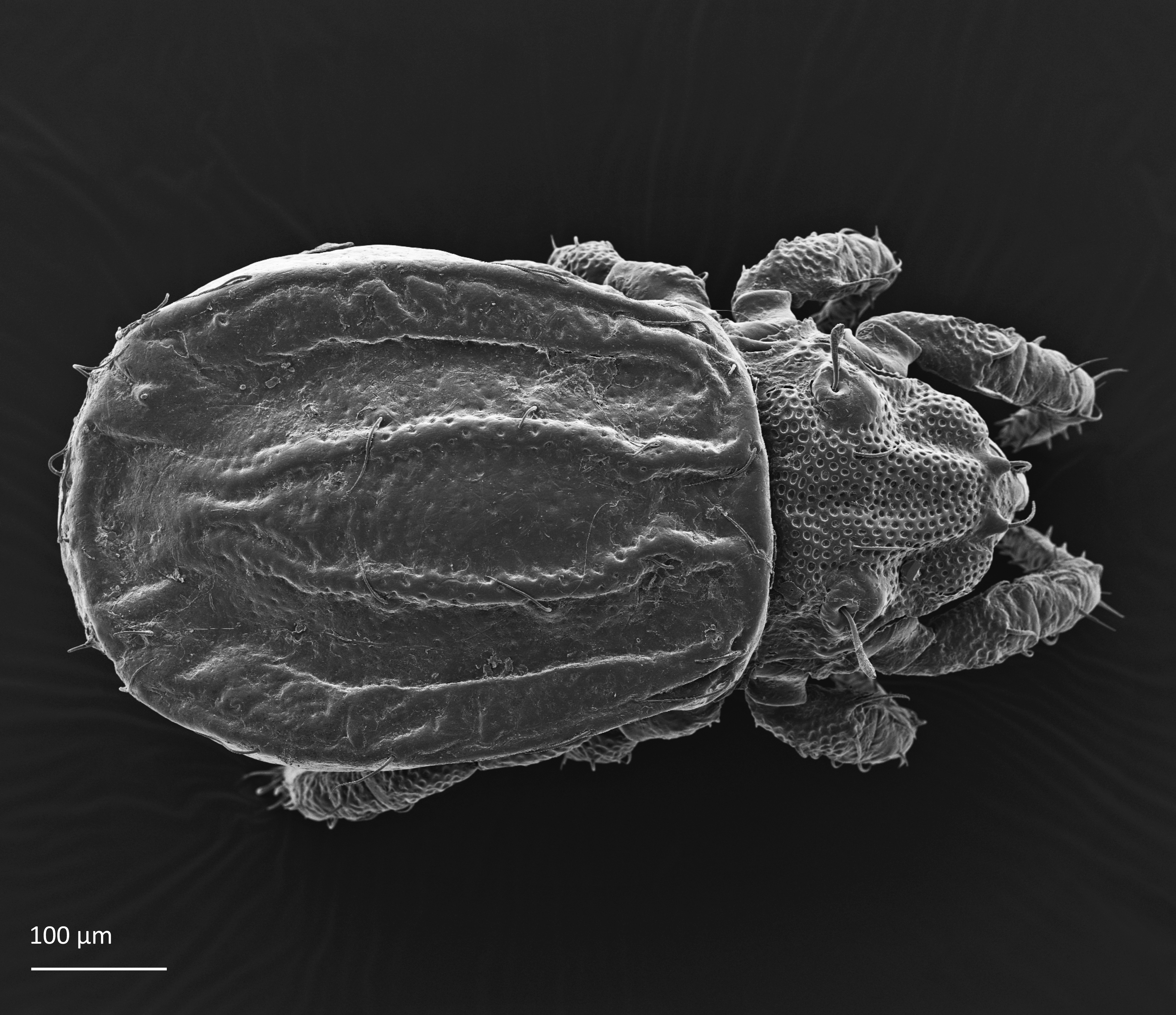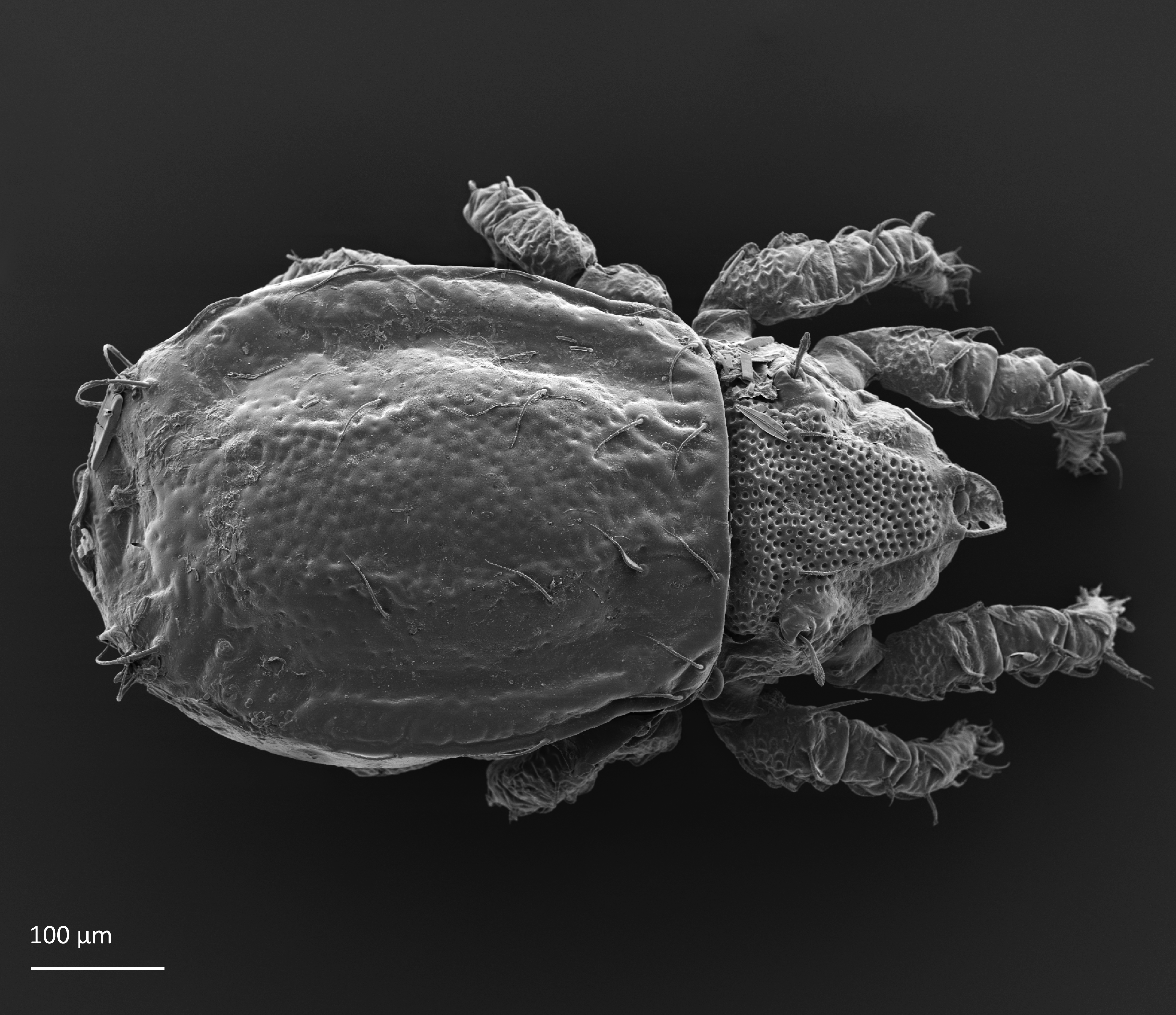Crotoniidae
The family Crotoniidae occurs worldwide, and many species are camouflaged by adherent organic debris.
- Innhold
- Characteristics
- Habitat and ecology
The family Crotoniidae includes five genera, three subgenera, 169 species and four subspecies (Subías 2023).
Characteristics
The adults are medium sized to large (530–1240 µm long) and brown. Their body is often covered with adherent organic debris. The anal plate is wider or only slightly narrower than the adanal plate. The genital setae are situated on the medial margin of the genital plates and delimited from the rest of the plate by a distinct carina. Aggenital setae are present (Weigmann 2006, Norton and Behan-Pelletier 2009, Behan-Pelletier and Lindo 2023).
Habitat and ecology
Crotoniidae occupy a wide range of habitats, from dry to aquatic environments. They live on the tree trunks, in the tree canopy, in epiphytic lichens, among mosses and lichens on rocks, in forest soil, litter and mosses, in rotten wood, in bracket fungi, in peatlands, and various freshwater habitats, including benthic habitats. They have also been found in the feathers of birds and in the hair of small mammals (Behan-Pelletier and Lindo 2023). They feed on algae, hyphae and spores of fungi, on organic matter, including higher plant remains, on conifer pollen, and on arthropods.
Crotoniidae are parthenogenetic (Maraun et al. 2019), only females are present, and they are produced from unfertilized eggs. The time of development has been studied in seven species of Crotoniidae, mostly under laboratory conditions but sometimes also in the field (Pfingstl and Schatz 2021). The best studied species is Platynothrus peltifer (C.L. Koch, 1839). In the laboratory, the development of this species from egg to adult lasted 154–216 days at the temperatures 20.5–22.5 °C (Ermilov 2008), and 330–365 days at 3–15°C (Weigmann 1975). In the field, at the mean annual temperature of 5°C the development of Platynothrus peltifer from egg to adult lasted 240–300 days (Block 1965).
References
Behan-Pelletier VM and Lindo Z (2023). Oribatid Mites. Biodiversity, Taxonomy and Ecology. CRC Press, 508 pp.
Block W (1965). The life histories of Platynothrus peltifer (Koch 1836) and Damaeus clavipes (Hermann 1804) (Acari – Oribatei) in soils of pennine moorland. Acarologia 7(4), 735–743.
Ermilov SG (2008). The laboratory cultivation of oribatid mites of the superfamily Crotonioidea (Acari, Oribatida) with the purpose of studying their development. Ministry of Agriculture of the Russian Federation, Nizhniy Novgorod, 1-54. [in Russian]
Maraun M, Caruso T, Hense J, Lehmitz L, Mumladze L, Murvanidze M, Nae I, Schulz J, Seniczak A and Scheu S (2019). Parthenogenetic vs. sexual reproduction in oribatid mite communities. Ecology and Evolution 9(12), 7324–7332. doi.org/10.1002/ece3.5303
Norton RA and Behan-Pelletier VM (2009). Suborder Oribatida. In: GW Krantz and DE Walter (eds.). A manual of Acarology, 3rd ed. Texas Tech. University Press Lubbock, 430–564.
Pfingstl T and Schatz H (2021). A survey of lifespans in Oribatida excluding Astigmata (Acari). Zoosymposia 20, 007–027. doi.org/10.11646/zoosymposia.20.1.4
Subías LS (2023). Listado sistemático, sinonímico y biogeográfico de los Ácaros Oribátidos (Acariformes, Oribatida) del mundo (1758−2002). Graellsia 2004, 60 (número extraordinario), 3−305. Updated 2023 – 18 actualization, 540 pp., access December, 2023.
Weigmann G (1975). Labor- und Freilanduntersuchungen zur Generationsdauer von Oribatiden (Acari: Oribatei). Pedobiologia 15, 133–148.
Weigmann G (2006). Hornmilben (Oribatida). Die Tierwelt Deutschlands. 520 pp. Vol. 76, Goecke and Evers, Keltern.

